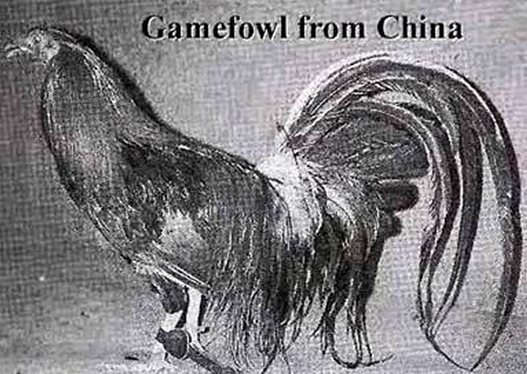|
China Game, Hainan Fowl 海南鸡
written by David Rogers, as told by Toni-Marie Astin's friend Ms. Ping The fowl known in the US as "China Game" originated in the tropical Hainan Province of Southern China. Though they now exist throughout China. Hainan is a Chinese word meaning, "South of the Sea." Hainan Province has 97% of its land mass on Hainan Island, "Hainan Dao". The remaining 3% of its land mass is scattered across some two hundred smaller islands in the region. Hainan first appears in written history ca. 110 BC. Its first inhabitants are estimated to have arrived there some 3,000 years ago. It is not known how long the fowl have been bred there. The fowl are referred to properly as "Hainan Fowl". However, individuals in many rural populations refer to them simply as "tail fighters". Their physical appearance and occasional mutations suggest they have Green Jungle Fowl from Java in their ancestry. Aside from the long tail feathers of the rooster, pea-combed birds having one centrally located wattle and rounded neck feathers are known to exist within the flocks of older, long-time breeders. This suggests that southern China had trade with Java, Indonesia, prior to the 7th century AD. Black-breasted red is the most common plumage color pattern. Silver and gold ducking is also known to exist. As well as black-tailed red ginger. Leg colors are green and yellow, varying even within the same flock. Corn is an expensive commodity that is not readily available. Brown rice itself is not necessarily fed to the fowl either due to its demand as a staple of the human diet. So only the byproducts of brown rice, fruit, and vegetables are fed to the fowl. Hainan Island is a typhoon prone location. Debris from the sea often washes up on the beaches. Dead fish, crustaceans, and sea weed are commonly collected from the beaches and fed to livestock, including the Hainan fowl. Despite this diet of rice byproducts and sea refuse, it seems the fowl do well in the US living on other grains. This is in stark contrast to other fowl such as non-molting long-tail fowl that have a similar diet in their native country of Japan and do best maintained on such a diet. The fowl were fought sometimes ceremoniously at specific times of the year. It's said that they would not fight during the winter months and were used mostly during the spring and summer months during breeding season when the roosters were already prone to fighting. Today the fowl are still used in this manner in rural villages in China. Elsewhere outside of China they are kept as pets and ornamental fowl. China Game By Casey Joslyn The China(Chinese) Game Fowl are truly a magnificent breed in their own. They sport massive tail feathers in length as well as height and saddles that drag the ground. These are also of aggressive behavior, however seem to show the intelligence of tacticle defense as well as breed personality. They appear to be showing great vigor and disease resistance as well, producing chicks in numbers that hatch off quite well with little to no problems. These fowl, originating from China, were brought to the states in the early 1930's. Mr. Herman Pinnion had Chinese Immigrants who worked on his farm and these were their birds. It is not unheard of that these were also crossed to Mr. Pinion's own American Game Fowl, creating some which had pea comb and long tails and saddles. The China Games come in a variety of colors and weigh in the range of 5-7lbs depending on conditioning. They usually have a pea to cushion comb and pearl to Yellow, and Green legs. In the last year I have been hatching off mostly goldens, silvers, red pyles, some mahogany and several recessive whites. The hens are good layers of medium sized eggs that are usually white to cream colored and males showing great fertility levels as well as the hens. My intentions are to preserve this breed back to "saddle draggers" as well as keeping the game state. Selections for such type as well as pea comb birds with light colored legs will be my focus in the future. Reference:
0 Comments
Your comment will be posted after it is approved.
Leave a Reply. |
Categories
All
Archives
January 2013
|


 RSS Feed
RSS Feed
